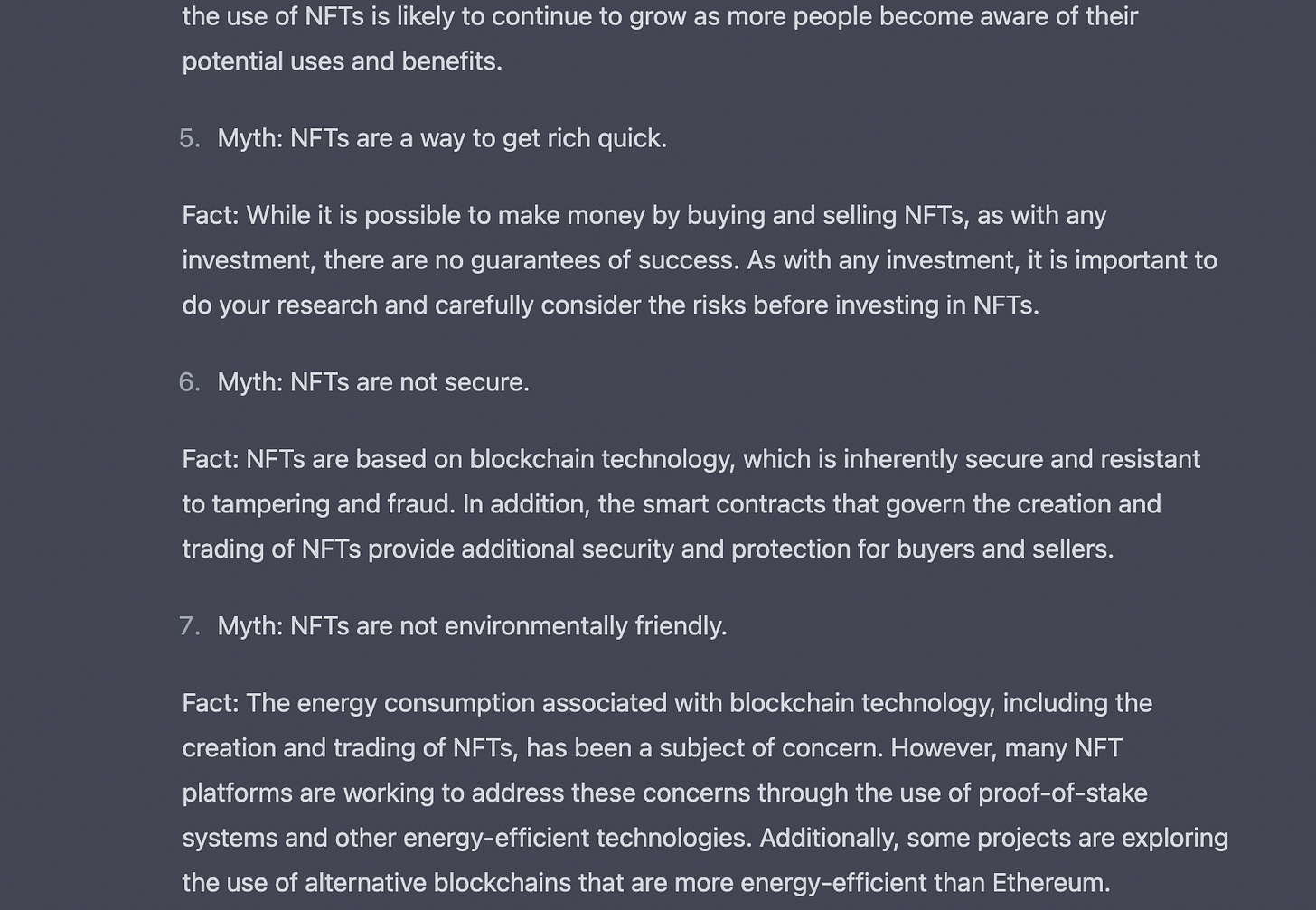The AI Does Not Hate You
"The AI does not hate you, nor does it love you, but you are made out of atoms which it can use for something else." - Eliezer Yudkowsky
Earlier this month I released our 14th letter, “7 Common Myths About NFTs”. In it, I tackled a few of the most persistent myths that linger in the space: NFTs are a fad, they’re a way to get rich quick, they aren’t environmentally friendly, and so on. You’ve heard it all before.
Was that article perhaps simpler than what I usually write? Absolutely. In my defense, I was pressed for time. In any event, it did well: our readers seemed to enjoy it, it had a high open rate, and it more or less hit the metrics I would want to see for any of our letters.
The thing is, I didn’t actually write it. AI did. For anyone who needs a reminder, artificial intelligence (AI) is a field of computer science that focuses on creating intelligent machines that can mimic human cognitive functions such as learning and problem solving.
Specifically, the AI I used was ChatGPT, an elaborate language model AI meant to replicate “human-like” text.
So, before I dust off my resume and AI takes my job, let’s unpack how this interesting development unfolded.
So What Did I Write?
Remarkably little.
An admittedly short letter by my standards, it only weighed in at a couple of pages, double spaced. Excluding my author byline and copy-pasted call to subscribe, the article ran in at 539 words.
Here is the totality of what I wrote:
“Letter 14: 7 Common Myths About NFTs”
and
“In the case of the Ethereum blockchain, for instance, the first NFTs appeared in 2015 and gained limited popularity in 2017.” (I had to correct one tiny detail: ChatGPT seemed to think CryptoKitties were the birth of NFTs on Ethereum, in 2017).
For those of you who are counting, that’s only 28 words. Everything else, the AI wrote.
It wrote my subtitle.
It wrote the intro.
It wrote the 7 myths.
It wrote the quotes I used.
It wrote my conclusion.
28/539. That’s around 5% made by a living, breathing human.
To be fair, I also chose the two pictures I used in the article. But, had I still had my membership to Midjourney or Stable Diffusion (AI which produces images from text prompts), I could have given that task to the AI as well. All in all, I spent maybe 15 minutes giving it the prompt, assembling it in Substack, choosing my photos, and publishing.
Was it the greatest article? No. But it was also one of my earliest attempts, and I let it ramble for two pages with nearly no editing or further direction. I hadn’t yet played around with different techniques to prompt it to write in a certain way, nor did I do anything like directing it paragraph by paragraph, in order to produce a more cohesive piece.
As it stands, the more direction you can provide, the better the output. Nate, our Director of Operations, also played around with ChatGPT, and by guiding it more closely, supplementing it with his own writing, and editing liberally, he was able to produce The History of AI: How the Field Has Evolved and Its Major Milestones, a text nearly three times as large as my last letter and considerably more specific.
But back to my early experiment. Below is the text prompt and output which became the body of my previous letter.

Now, this was going to be the part of the article where I shared all the amazing things people have already made with ChatGPT, but then Zeneca came along with his newest article, and did it for me.
Pro tip: if AI or Zeneca can do your work for you, let them ^_^
So after you finish this, check out Zeneca’s article for a meaty AI discussion (the embedded ChatGPT tweets can be found a third of the way down).
How is AI Helping, TODAY?
"Artificial intelligence would be the ultimate version of Google. The ultimate search engine that would understand everything on the web. It would understand exactly what you wanted, and it would give you the right thing. We're nowhere near doing that now. However, we can get incrementally closer to that, and that is basically what we work on."
- Larry Page, co-founder of Google
AI is not some distant technology the world is waiting on. AI is here and it is now. Most people have not considered just how deeply AI is already embedded in society. Consider just a few examples:
Transportation & Logistics: AI algorithms optimize delivery routes, reducing fuel consumption and traffic congestion. Self-driving cars can drive without exhaustion and study and navigate the roads with a host of useful data to make split-second decisions in real-time for safety and efficiency.
Healthcare: AI is already used to study and analyze large amounts of medical data in order to find patterns and make predictions about health. This helps doctors diagnose and treat specific diseases more accurately, as well as detect those diseases at earlier stages. Working with medical image analysis tools such as MRIs and X-rays, AI can detect abnormalities such as tumors even better than trained doctors and medical technicians.
On a personal note, I wear hearing aids that were trained with a deep neural network of over 12 million sounds, which is leagues above the non-AI hearing aids I’ve tried. The AI is better than humans at detecting and recognizing patterns in sound, and it amplifies or dampens noises accordingly.

Finance: AI has a solid history of use in finance. It can identify potential loan risks, analyze spending patterns to better improve fraud detection, make credit decisions, and more. It will likely continue to adapt and expand its functionality alongside advancements in AI.
Agriculture: Increasingly, AI equipped drones are used to monitor soil health, apply fertilizer, search for signs of pests and disease, improve crop yield, and reduce the use of pesticides by applying more specific, targeted applications. AI can also analyze satellite images and other data to identify areas of the farm where crops are growing poorly.
Education: AI-powered tutoring systems can provide personalized instruction to students, helping them learn more effectively. It can grade essays and other written assignments, allowing teachers to provide greater individualized feedback to their students. In the future, AI-based education may lead the way in discovering intuitive means for humans to optimize learning, replacing current popular methods such as spaced repetition systems.
Artificial General Intelligence: the Next Leap in AI Tech
"The real risk with AI isn't malice but competence. A superintelligent AI will be extremely good at accomplishing its goals, and if those goals aren't aligned with ours, we're in trouble."
- Nick Bostrom, philosopher/author
ChatGPT, as impressive as it is, is still what most would call “Narrow AI” or “weak AI”. Narrow AI is generally limited to a specific task or a series of tasks, and it is already in use today. But don’t let narrow/weak fool you: every example I provided in the previous section falls under the domain of narrow AI. It is still mightily impressive.
The future to which we’re headed is one in which we have Artificial General Intelligence, otherwise known as “Strong AI”. Strong AI is not built for only a specific task; it can learn and behave in many the same ways humans do, such as displaying genuine intelligence, creativity, self discovery, and potentially even emotion.
AGI is the stuff of Sci-Fi utopias and dystopias. It does not exist as of yet, so it remains to be seen what direction—if any—humankind takes things.

Understanding Limitations
It is important to note that AI like ChatGPT is not infallible. It was trained from sources online, and as we all know, people on the internet are often wrong. Because of this, it sometimes has the tendency to lean towards the popular answer, rather than the correct one (hence the CryptoKitties answer I had to edit). Additionally, it has difficulty with providing information about current events, as it is not connected to the internet, and its knowledge cut off was somewhere in 2021.
Having used ChatGPT and comparative tools like Jasper AI, I’ve found them to be incredibly useful. As a tool for drafting, editing, providing arguments you haven’t considered, and things you may have overlooked, it is outstanding. I believe it goes a long way in helping build the connective tissue of your writing, which can save you a lot of time.
As far as content creators go, I don’t believe we’re at the stage yet where anyone should consider handing off the reigns of their writing to our AI overlords. Not only does it feel as though we’re not quite there yet, but there is a long ways to go in terms of developing voice and style, as outputs can often seem stilted and unpersonalized.
But we’re close. Probably closer than most of us think.
Major Drag, Huh?
John Connor: “We’re not gonna make, are we? People, I mean.”
T-800: “It’s in your nature to destroy yourselves.”
John Connor: “Yeah. Major drag, huh?”
- Terminator 2: Judgement Day
At the end of the day, ChatGPT can produce articles better than a surprising amount of writers online. Although I always assumed the arts would be the last bastion of human ingenuity and unable to be replicated, 2022 has shown me that not only is AI possible of making passing (and even exceptional) work, but that it won’t need nearly as much time as I thought to disrupt entire professions.
I’m not going to lie: I say with a certain degree of sincerity that one of my biggest goals over these next few years is to become financially independent and specialize in enough fields so as to limit (or at least slow) the rate at which I’m made effectively obsolete.
Any industry you can imagine will move to adopt AI if it means increased productivity, and lower costs. And that’s fine and dandy. The concern, of course, comes from the fact that while AI is advancing quickly, we are not keeping up at the same pace. Without universal basic income and major overhauls to protection for workers, AI is poised to be incredibly disruptive and damaging to the livelihood of millions, if not billions of humans. But we cannot pretend that this isn’t coming. Technophobes have never gotten their way. Once technology develops a better, faster, cheaper solution to a problem, it is the inevitable outcome.
Ironically enough, I asked ChatGPT for advice about how to remain in demand in the workforce, given all the advancements in AI technology. It told me that I should develop skills that will remain essential such as: data analysis, machine learning, programming, and critical thinking. It also reinforced my own personal beliefs by reiterating that financial independence and universal basic income would go a long way in mitigating the risks of AI advancement.
My First Time Apologizing to AI
On a lighthearted note, I felt as though I should apologize to ChatGPT. To keep up the deception of the previous article, I said that I had written the letter. That isn’t ethical or moral by any standards. So, I thought it important to seek forgiveness from the AI.
See You in 2023!
Thank you all for joining us! This is our final letter of the year, as staff is going on holiday as of…right now! We’ll be spending time with friends and family, and getting back to the swing of things on January 3rd. Because of that, our next letter will probably come out somewhere before January 25th with the second monthly letter around the last day of the month.
We look forward to seeing you all in the New Year! 💙
Written by: Brad Jaeger
Director of Content @ Curious Addys (say hi on Twitter!)








